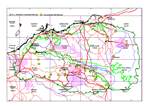Click on images
to enlarge


, BRM 8020, ORIGINAL SCAN, ADJUSTED RICHARD WOODMAN_sml.jpg)
Photographer: B.R. Maslin

Photographer: B.R. Maslin
, BRM 10 km from Tom Price, 17 July 1980_sml.jpg)
Photographer: B.R. Maslin

Photographer: J. Maslin
, LSWE 7024, lab photo by Fiona McCallum ADJUSTED_sml.jpg)
Seed from one herbarium voucher. Scale in mm. Photographer: F. McCallum.

Pinnate variant. Photographer: E. Thoma

Pinnate variant. Photographer: E. Thoma
Botanical name
Acacia spondylophylla F. Muell., Fragm. 8: 243 (1874)
Common name
Curry Wattle
Aboriginal name
Munyjungu (Nyangumarta)
Description
Dense or openly branched shrubs to about 1 m tall but frequently smaller (may reach 2 m tall outside the Pilbara), spreading (to about 2-2.5 m across), often procumbent and ±flat-topped, sticky-resinous (resin aromatic with a curry odour which is especially evident on living plants). Old stems marked with annular scars (formed by the short, persistent stipule bases) where phyllodes have fallen. Branchlets with short, straight, spreading hairs. Stipules triangular, 1-2 mm long, wide-spreading, brown. Phyllodes arranged in whorls (8-14 phyllodes per whorl) separated by internodes that are normally shorter than the phyllodes, linear to linear-oblanceolate, 5-10 (-15) mm long, less than 1 mm wide, wide-spreading, straight to shallowly incurved but often slightly recurved at the tips, flattened and finely longitudinally wrinkled when dry, invested with short, spreading hairs, bright green, slightly viscid; nerves not evident; somewhat gradually narrowed at apex into a distinct, short, subulate, non-spiny point. Inflorescences simple; peduncles 10-25 (-35) mm long, sparsely pilose to sub-glabrous; heads large, globular, golden, 25-40-flowered. Flowers 5-merous; sepals half-united or free to base, glabrous; petals nerveless or obscurely 1-nerved (not striate as in A. adoxa), glabrous. Pods narrowly oblong, flat but prominently rounded over seeds alternately on each side (giving pods an undulate appearance), not constricted between seeds, 2-5 cm long, 6-10 mm wide, ±sessile or very shortly stipitate (stipe to about 2 mm long), shallowly to moderately curved, thinly coriaceous-crustaceous, sticky, glabrous, brown; margins pale-coloured. Seeds transverse to transversely oblique in the pods, small (3.5-4 mm long), blackish.
Characteristic features
Sticky, resinous, low shrubs with a distinctive aromatic curry smell (at least when fresh). Branchlets and phyllodes invested with short, spreading hairs. Phyllodes arranged in whorls (8-14 per whorl), mostly 5-10 mm long, wide-spreading, bright green. Heads large, on long peduncles (mostly 10-25 mm); petals not striate, glabrous. Pods prominently rounded over seeds alternately on each side (giving pods an undulate appearance).
Distribution and ecology
Occurs in scattered localities from the Pilbara region to the Rawlinson Range in Western Australia, eastwards through the Macdonnell and Musgrave Ranges in Northern Territory to far western Queensland. In the Pilbara Curry Wattle has a widespread, scattered distribution. It is not an especially conspicuous element in the landscape although it commonly forms localized colonies in the places where it occurs. It favours rocky hills (especially the eastern and southern slopes) in spinifex country and is often associated with seasonally dry watercourses; it frequently grows with A. hilliana, A. tumida var. pilbarensis and occasionally with A. adoxa var. adoxa. It grows on rocks (e.g. ironstone, jasperlite, pisolite or basalt) of the Jurina or Brockman Iron Formations.
Flowering and fruiting period
Flowers from June to August with a peak in July, although judging from the specimens it is possible that flowering earlier in the year may sometimes occur. Pods with mature seed have been collected between August and October.
Variation
A highly unusual specimen characterized by pinnate leaves with a few terminal leaflets on each has been collected from one location in the Pilbara. The solitary plant from which this specimen was collected no longer exists. This entity is seemingly related to A. spondylophylla and may indeed represent some sort of neotenous form of that species. Acacia spondylophylla (erect variant) is most probably just a localized variant of A. spondylophylla.
Affinities
The only other species in the Pilbara with whorled phyllodes is A. adoxa which is most readily recognized by its striate petals, generally shorter, erect phyllodes, smoky grey-blue foliage ( var. adoxa); A. adoxa does not have the distinctive curry odour of A. spondylophylla (smell most obvious on living plants). It is likely that these two species hybridize in a few places in the Pilbara (see A. adoxa var. adoxa x spondylophylla for discussion). In areas outside the Pilbara A. spondylophylla is often confused with A. perryi and may be related to A. hippurioides.
Notes
This species is drought tolerant and regenerates from seed.
Acacia spondylophylla has considerable horticultural potential as a ground cover or for rockery plantings. It is an attractive, low, sticky shrub with a distinctive curry odour.
Conservation status
Not considered rare or endangered.
Origin of name
The botanical name is derived from the Greek spondylos (vertebra, joint) and phyllon (leaf) and refers to the older branches which have the appearance of vertebrae along a spinal column (backbone), produced by the annular 'scars' where phyllodes have fallen.
